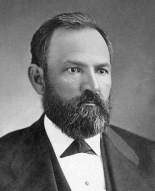Robert Wilkinson Furnas facts for kids
Quick facts for kids
Robert Wilkinson Furnas
|
|
|---|---|
 |
|
| 2nd Governor of Nebraska | |
| In office January 13, 1873 – January 11, 1875 |
|
| Preceded by | William H. James Acting Governor |
| Succeeded by | Silas Garber |
| Personal details | |
| Born | May 5, 1824 near Troy, Ohio |
| Died | June 1, 1905 (aged 81) Lincoln, Nebraska |
| Political party | Republican |
Robert Wilkinson Furnas (born May 5, 1824 – died June 1, 1905) was the second Governor of Nebraska. He was born in Ohio and became an orphan when he was eight years old. Furnas was a "self-made man," meaning he achieved success through his own hard work and effort. Before he entered politics, he worked many different jobs. He was a farmer, a printer, a tinsmith, an insurance salesman, and even a postmaster. He had eight children.
Contents
Robert Furnas: A Life of Service
Starting a New Life in Nebraska
Furnas moved to Nebraska in 1856 when he was 32 years old. He settled in a town called Brownville, Nebraska. Just two months later, he started a newspaper called the Nebraska Advertiser. This paper helped to share information about farming chances in Nebraska. He also started the Nebraska Farmer, which was the first farming magazine in Nebraska. It is still published today!
Early Steps in Politics
In 1856 and 1858, Furnas was chosen to be part of the Legislative Assembly of Nebraska Territory. This was like the local government at the time. In 1857, he worked as the public printer for the Nebraska Territory. This meant he printed official government documents. By 1861, he was the main clerk for the Territorial Council.
Helping During the Civil War
During the Civil War, Furnas became a colonel. A colonel is a high-ranking officer in the army. He was part of the local army, called the territorial militia. This militia was loyal to the Union, which was the northern side. In 1862, he led three groups of Native American soldiers. These groups were fighting with the Union Army. He even captured a Native American chief named John Ross from the Cherokee people.
After the War: A Busy Man
After the war ended, Furnas continued to serve the public. He worked as an Indian agent for several Native American tribes. These included the Omaha, Winnebago, and Ponca tribes. An Indian agent was a government official who worked with Native American tribes.
Furnas was also involved in education. He was a member of the board of regents for the University of Nebraska from 1869 to 1875. He helped lead the Nebraska State Historical Society as its first president from 1878 to 1890.
He also represented the United States at several big events. He was a commissioner for the Philadelphia Centennial Exposition. He also served at the New Orleans Cotton Centennial and the Chicago Columbian Exposition. These were large world's fairs that showed off new ideas and products.
Furnas held many other important roles. He was president of the American Fair Association. He also led the State Horticultural Society, which focuses on growing plants. He was a leader in the Masons, a social group. He was the first president of the Nebraska Teachers Association. He also led the State Board of Agriculture. He worked as the secretary for the State Board of Agriculture until he died.
Governor of Nebraska
Furnas was chosen by the Republican Party to run for governor. He won the election and became the Governor of Nebraska. He served as governor from 1873 to 1875.
His Last Years and Legacy
Furnas passed away in 1905. He was buried in Walnut Grove Cemetery in Brownville, Nebraska.
What He Left Behind
Furnas helped to create Arbor Day when he was governor. Arbor Day is a special day when people are encouraged to plant trees.
Furnas County, Nebraska, a county in Nebraska, is named after him. This shows how important he was to the state.
In 1979-1980, he was added to the Nebraska Hall of Fame. This honors people who have made a big difference in Nebraska.

